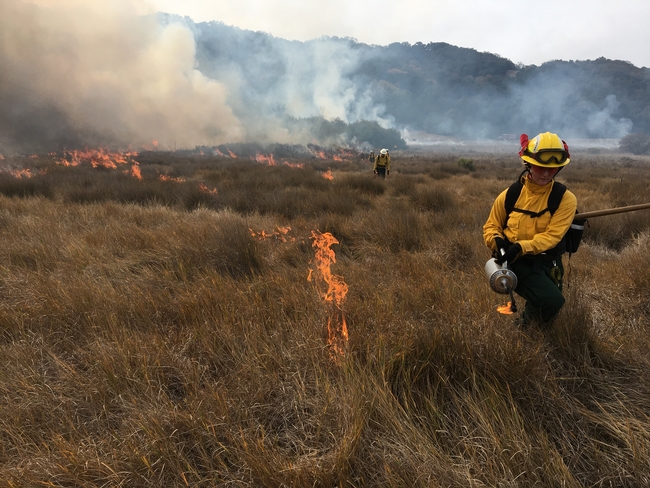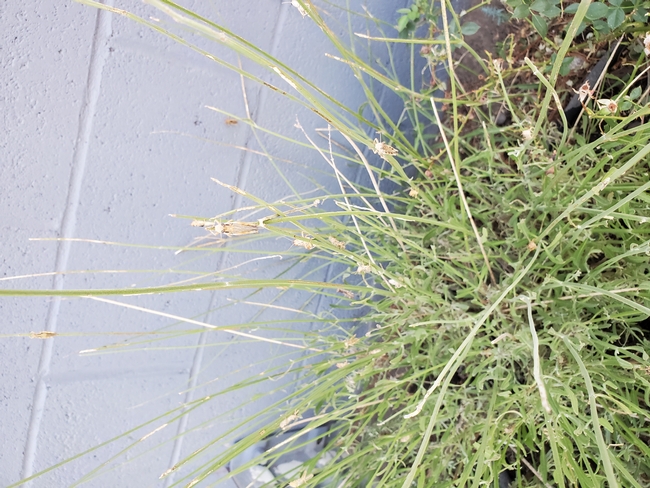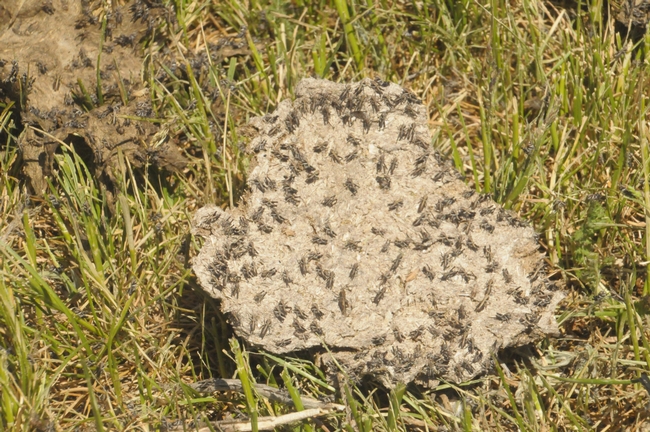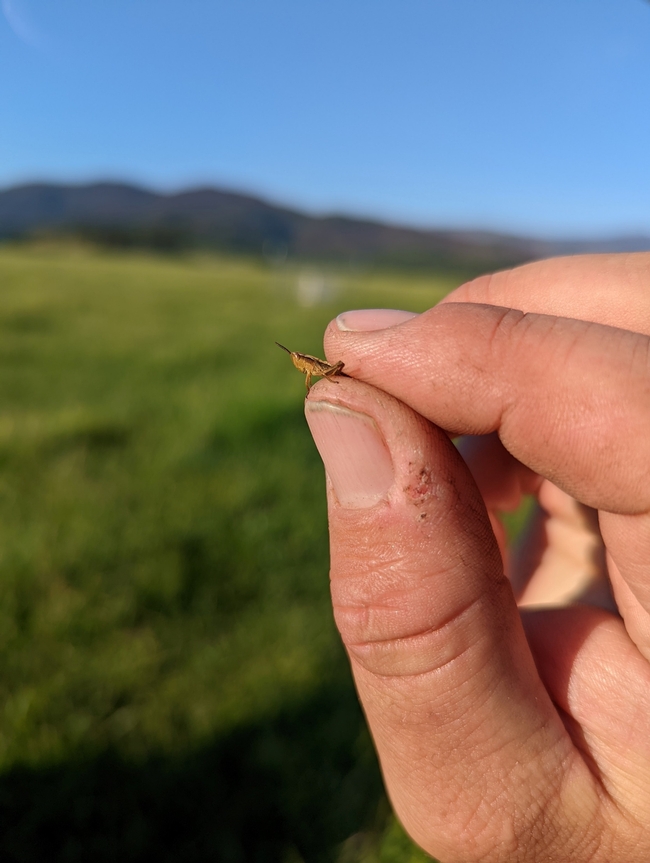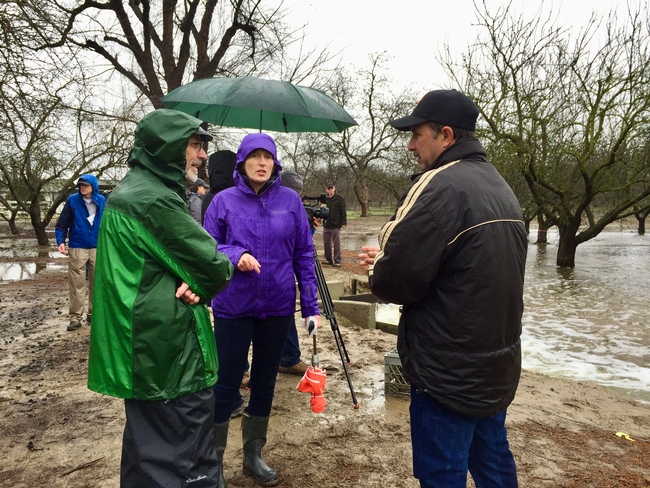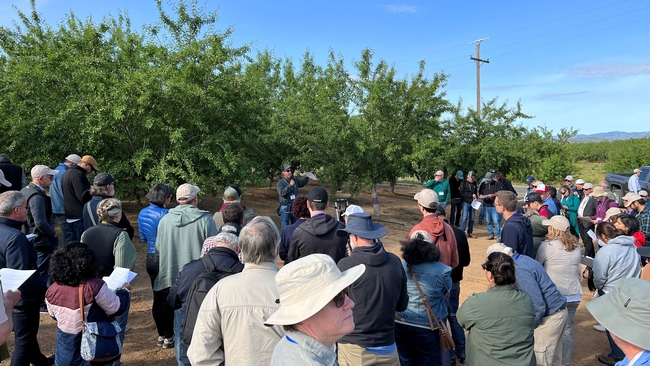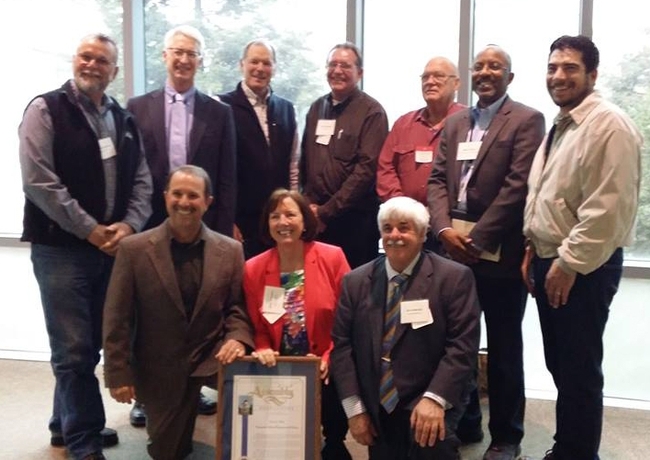News stories
Public invited to see ‘good fire’ Oct. 5 at Central Coast fair
Learn the how, where and why fire is used to manage the natural landscape at the Central Coast Good Fire Fair on Saturday, Oct. 5. The fair is free and open to the public from 10 a.m. to 3 p.m. at Henry Cowell Redwoods State Park in Felton in Santa Cruz County. The event is sponsored by the UC Agriculture and Natural Resources Fire Network and California State Parks.
“You can witness a live prescribed fire in the redwood grove and learn about using fire in our coastal ecosystems,” said Barb Satink Wolfson, UC Cooperative Extension fire advisor for San Benito, Santa Clara, Monterey and Santa Cruz counties.
Representatives of California State Parks, CALFIRE, indigenous groups and the Central Coast Prescribed Burn Association are scheduled to talk about how they work with fire.
The Good Fire Fair will offer educational activities for children and adults:
- Learn how to safely build, tend and extinguish a campfire
- Watch live burns of piles and redwood understory growth (likely between 11 a.m. and 1 p.m., depending on the weather)
- Savor sandwiches, burgers and Venezuelan food from local food trucks
- Observe demonstrations and visit informative booths
- Learn how to make your home more resilient to wildfire
- Test your fire knowledge and win prizes
“Kids will get to see a wildland fire engine up close, try fire science experiments and play educational games. Bring a camera,” said Satink Wolfson. “Knowledge feeds the soul, but two of Santa Cruz's best food trucks will feed your hunger!”
The event is free, but parking at the park is $10. No registration required.
UCCE offers water measurement training Sept. 13 in Salinas
California water-rights holders are required by state law to measure and report the water they divert from surface streams. For people who wish to take the water measurements themselves, the University of California Cooperative Extension is offering in-person training to receive certification on Sept. 13 in Salinas.
At the workshop, participants can expect to
- clarify reporting requirements for ranches.
- understand what meters are appropriate for different situations.
- learn how to determine measurement equipment accuracy.
- develop an understanding of measurement weirs.
- learn how to calculate and report volume from flow data.
The training is scheduled for 1 to 5 p.m. on Sept. 13 in the UC Cooperative Extension Conference Room at 1432 Abbott Street in Salinas.
“We are limiting the number participants for the water measurement training to 30 people per session,” said Larry Forero, emeritus UC Cooperative Extension livestock and natural resources advisor. “If you need this training, please register soon.”
Pre-registration is required and the fee is $30. To register, visit https://surveys.ucanr.edu/survey.cfm?surveynumber=43495. If you have questions, email Forero at lcforero@ucanr.edu or Sara Jaimes at sbjaimes@ucanr.edu, or call (530) 224-4900.
UC seeks toddler volunteers for milk study
Researchers to study whether whole or low-fat milk is best for toddlers
San Francisco Bay Area toddlers who drink cow's milk are being sought to participate in a 12-month study by UC Nutrition Policy Institute, a part of University of California Agriculture and Natural Resources. Milk will be provided for free to participants.
Milk provides children with calcium, protein and vitamin D, which are essential for health and brain development. In the U.S., the American Academy of Pediatrics recommends that children switch from whole milk to low-fat or nonfat milk after age 2 to reduce their intake of saturated fat and calories.
“The purpose of this UC study is to see how the type of milk toddlers drink affects their health, growth and development,” said Kassandra Bacon, NPI project policy analyst.
Researchers with the Nutrition Policy Institute are recruiting children ages 23 to 30 months old. The 625 toddlers will be randomly assigned to drink either whole fat or 1% fat milk starting at age 2. The scientists will assess diet, health and developmental outcomes.
“We will follow each participant for one year, collecting baseline and follow-up data,” said Ryan Williams, a NPI project policy analyst and registered dietitian who is involved in the research.
For 12 months, the scientists will measure each child's height, weight, waist and head circumference. At the beginning and end of the study, parents will be required to take their children to a local lab for a blood draw to assess lipids, cholesterol, insulin resistance and vitamin D status, as well collect a sample of their child's stool so the scientists may analyze the gut microbiome. During a home visit, researchers will also interview parents about their child's development.
Benefits to participants
The assigned milk type will be delivered to participants free of charge via a grocery delivery service. Participating parents will receive advice from a registered dietitian to support healthy milk consumption as part of a balanced diet. The Nutrition Policy Institute also will send the parents monthly newsletters with general health tips. Participants also may earn up to $275 in gift cards by completing the study.
Requirements to participate
Participants for the milk study must meet these requirements:
- Child must be 23 to 30 months old and have public or private medical insurance
- Child's parent/legal guardian must be 18 years or older
- Child must live with the participating parent/legal guardian in the San Francisco Bay Area (Alameda, Contra Costa, Marin, Santa Clara, San Francisco or San Mateo counties)
- Child's parent or guardian must speak English
Children are ineligible for the study if they are:
- a WIC participant
- lactose intolerant
- allergic to milk protein
Lorrene Ritchie, NPI director and registered dietitian, and Anisha Patel, pediatrician at Stanford Medicine Children's Health and professor in the Division of General Pediatrics at Stanford University, are the principal investigators for the study.
For more information about the research and to sign up for the study, visit https://npi.ucanr.edu/milk.
Grasshoppers gobble crops, farm profits
UCCE advisors share control, abatement strategies across Northern California
That buzzing noise in Northern California is the sound of grasshoppers chewing a path of destruction through crops and pollinator-friendly plants as they hop across an expanding area.
This is the fifth year in a row that massive numbers of grasshoppers have overrun Modoc County and “probably the worst I've seen yet,” said Laura Snell, a University of California Cooperative Extension livestock and natural resource advisor in Modoc County, located in the northeastern corner of the state.
In past years, Snell has heard from farmers who have lost up to 70% of their hay crop. This year, she is hearing of grasshopper damage from farmers who grow a wider array of crops, including onions and garlic – crops that the pests eschewed in past years.
“I've had an even broader group of producers contact me about damage,” Snell said. “Our local vegetable producers are being affected, decreasing farmers market and food hub products. Bee producers are not seeing good honey yields due to grasshoppers eating huge amounts of pollinator plants.”
Modoc County isn't alone. Lassen, Sierra, Plumas, Siskiyou, Tehama, Butte, Placer and Nevada counties are being invaded by grasshoppers.
“The county ag commissioners are circulating a survey to get an idea of other counties that may be affected,” Snell said. “Things like droughts and – I suppose, fires as well – would affect grasshopper migrations.”
While scientists don't know what's causing the explosive growth of grasshopper populations, there are some contributing factors, according to Tom Getts, UC Cooperative Extension weed ecology and cropping systems advisor for Lassen, Modoc, Plumas and Sierra counties.
In the past, grasshopper outbreaks seemed to be more isolated, and the populations tended to crash after a year or two. Getts said, “For whatever reason, the population cycle does not appear to have been broken, and they continue to have high numbers.”
Grasshoppers can consume 30% to 250% of their body weight per day, according to a fact sheet about grasshoppers, co-authored by Getts. While grasshopper nymphs walk, adults can fly 15 miles or more.
Getts and UC Cooperative Extension farm advisors have been giving presentations throughout the intermountain region on grasshoppers and the various control methods.
“The difficulty to controlling them is the scale and their ability to move,” Getts said. “The insects need to be targeted at a small growth stage for the tactics to be most efficacious. Once they are adults, it doesn't matter what one grower does to control them if their neighbor doesn't do anything.”
UCCE farm advisors in multiple counties are working on abatement options.
They recommend monitoring in April–May to control grasshoppers while they are still nymphs and susceptible to insecticides. Birds, spiders, rodents and fungi also can help keep the insects in check, but years of drought have reduced the fungi.
“The population of grasshoppers in the region have increased in size, scope and density in recent years,” said Rob Wilson, a UC Cooperative Extension agronomy and pest management advisor and director of the Intermountain Research and Extension Center in Tulelake.
The massive growth and spread of the pests is a problem because 30 pounds of grasshoppers can eat as much forage as a 600-pound cow can eat per day, he explained.
Part of the challenge of controlling grasshoppers is their changing behavior. In the past, grasshoppers would go away after a couple of years, now they persist. They used to thrive in dry fields, but last year, grasshoppers migrated 10 to 20 miles into irrigated fields, Wilson said.
Wilson, who has been monitoring grasshoppers near Tule Lake since early April, said that In some fields, there were 20 to 30 nymphs per square yard. More than eight nymphs per square yard can cause economic damage.
As if the grasshoppers themselves weren't enough of a nuisance, they attract other pests, including blister beetles.
“As the grasshopper population increases, you are bound to see an increase in all of the species that eat them over time,” Getts said. “Blister beetles cause terrible blisters when they get on your skin, hence the name, but they can also be problematic for livestock if they contaminate bales of hay.”
Getts recommends that growers take steps to prevent grasshopper populations from building over successive years. Growers should coordinate with neighboring growers to treat their fields due to the limited longevity and efficacy of treatments on individual fields.
[Editor's note: The sentence comparing the appetite of grasshoppers to that of cows was revised to clarify that grasshoppers aren't eating cows.]
Duncan’s research ‘blew up preconceived ideas,’ improved almond, peach, grape production
Roger Duncan, UCCE farm advisor in Stanislaus County, retires after 36 years
For more than three decades, tree fruit and nut growers have depended on the advice of Roger Duncan, UC Cooperative Extension pomology farm advisor in Stanislaus County, to improve their production practices. Duncan, whose research and extension program focused on almonds, peaches, grapes and other tree crops, retired July 1.
“Roger Duncan has been an extraordinarily relevant researcher for the predominant crops in Stanislaus County,” said Rep. John Duarte, owner of Duarte Nursery in Hughson. “His research has encompassed rootstock and variety selection, tree spacing, chemical inputs and spraying, fertilizers, pruning and replanting amongst other projects.”
Duncan began working for UC ANR in 1988 as a field assistant to Integrated Pest Management advisor Jim Stapleton after earning a master's degree in plant science and plant pathology from Fresno State and a bachelor's degree in the same subjects from UC Davis. In 1990, he became a UC Cooperative Extension in pomology farm advisor in Stanislaus County.
During Duncan's tenure, the planted acreage of tree and vine crops has tripled in Stanislaus County to nearly 1,900 farms on over 230,000 acres. His research has helped to improve production efficiency through improved rootstocks, crop varieties and production practices.
“Roger provides growers with resources and tools on nutrition, sprays, nutrient deficiencies, calendars, costs, pest management and other horticultural practices,” Duarte said. “His work has had significant impact on the productivity and quality of almonds, peaches and grapes. Breeders, universities, nurseries, growers and marketers have all gained from the wisdom and dedication of Roger Duncan.”
Growing up in Modesto, Duncan wasn't raised on a farm. “I had friends whose families farmed orchard crops, so I had some exposure,” he said. “I caught the Extension bug while working as a summer intern for the pomology advisors in the Stanislaus County UCCE office after I graduated with my B.S. That is what inspired me to return to school with the goal of being a pomology farm advisor.”
Reducing production costs
To help growers lower production costs, Duncan introduced orchard practices aimed at reducing hand labor and other inputs. As a result of his research, minimal pruning has become the norm in California almond production, reducing input costs and carbon output and increasing yield. He also improved monitoring and management techniques of established and invasive diseases and insect pests.
“The practical applications Roger brings to the grower community are invaluable,” said Mel Machado, Blue Diamond Almonds vice president for member relations and Stanislaus County almond grower. “His minimal pruning study stood growers on their heads. People had preconceived ideas about pruning. He blew that up. His research showed that after you get the tree's frame, all you need to remove are the dead and occluded branches. With the market depressed, we needed to cut costs. He said, ‘You don't need pruning.' Now I'm growing bushes.”
Art Bowman, a crop adviser with Salida Ag Chem, agreed that Duncan's pruning research had an impact. “Roger's pruning trial that lasted over 20 years was a much-discussed subject among growers,” Bowman said. “Growers' pruning practices definitely changed due to Roger's research, with early emphasis on structural development and, later in the tree's life, concentrating on tree accessibility and deadwood removal.”
In 1990, when Duncan joined UC Cooperative Extension, California had 408,700 acres of almonds, according to the California Agricultural Statistics Service. Now the state has over 1.5 million acres of almonds.
About 75% of the farms Duncan has served have 40 acres or less, farmed by “small” or “part-time” farmers, who needed to learn basic horticulture and pest management. Stanislaus County also is home to some very large, sophisticated growers, who Duncan has kept apprised of new technology.
“I believe that personal interaction offers the most memorable means of information transfer, which is why I held an average of 12-plus extension events per year, gave 18-plus extension presentations per year, and went on an average of over 75 individual farm calls per year,” Duncan said. He also provided information via videos, blogs, podcasts, radio shows, newsletters, news media and extension publications as well as commodity boards.
Along with Duncan's research, Bowman has appreciated his availability. “Roger was always ready to take a call, make orchard visits and listen to a grower's concern or problem,” he said.
In 1997, Duncan began hosting twice monthly Tree & Vine Integrated Pest Management breakfast meetings for pest control advisers and growers to discuss current and potential pest threats. These meetings have continued for 28 years.
He speaks ‘farmer'
Machado attributes much of Duncan's success to his communication skills. “His research is scientific and he speaks ‘farmer,'” he said.
Machado gave rootstock as an example. “Roger is my rootstock resource; he knows rootstocks better than anybody,” he said. “His rootstock trial is dirt simple. There's a different rootstock every five trees. You can see walking down the row the differences in the rootstocks.”
From his field evaluations, Duncan identified a complex hybrid rootstock that is highly tolerant to ring nematode, bacterial canker and salt toxicity. He found other hybrid rootstocks that boost crop yield while reducing risk from soil chemistry and soil-borne disease challenges, enabling almonds to be grown in the marginal soils on the west side of the North San Joaquin Valley. To help growers choose the appropriate rootstock for their soil, he wrote a comprehensive ANR publication, made a video and worked with the UC Fruit & Nut Center to create an interactive rootstock comparison website.
Over the last 15 years, use of hybrid almond rootstocks has increased dramatically. Burchell Nursery now sells approximately 40% of their trees on hybrid rootstock compared to less than 5% of almond trees 15 years ago, and more than 95% of Duarte Nursery almond trees are on hybrid rootstocks, according to Duncan.
“We've worked with Roger for years, back when he didn't have a mustache and then when he had a mustache,” said Robert Longstreth, who grows almonds, walnuts and cherries.
“Roger does research in the area you need, not frivolous stuff that you don't need,” said Longstreth, who has benefited from Duncan's research on pruning, rootstocks, irrigation timing, plant nutrition and disease control. “He's thought very highly of by almond growers. When he has something to say, people listen.”
The UCCE farm advisor has overseen long-term trials to learn how to design and maintain an almond orchard to capture early production, maintain long-term yields and maximize profits. “In the first 17 years of the orchard design project, I increased cumulative net profits by up to $14,000 per acre, including increased yield while reducing labor and carbon inputs,” Duncan said.
Influenced by Duncan's tree-spacing research results, growers have increased almond tree density by 20% per acre statewide, leading to higher crop yields, longer-living orchards and better farm economic sustainability.
As California's expert on almond rootstocks and almond orchard design, Duncan has taught the subjects for the UC Almond Production Short Course, was lead author on the UCANR publication “Almond Rootstocks,” wrote the rootstock chapter, and co-authored the orchard design chapter of the UC Almond Production Manual. He was invited to Chile, Spain and Australia to share his expertise with growers there.
Expanded programs for kids and gardeners
In addition to being a farm advisor, Duncan served as director of UC Cooperative Extension in Stanislaus County from 2011 through 2013 and again from 2017 through 2020. As the UCCE county director, he acquired new county funding to hire a 4-H youth development program representative in 2018 to provide more learning opportunities for local, underrepresented children.
That year, he also acquired county funding to hire a full-time Master Gardener coordinator and launched the first UC Master Gardener Program in the county.
“I felt very lucky to serve as an advisor in the same county where I was born and raised,” Duncan said. “I am most proud of the trust I have developed with the growers and other clientele.”
Professional awards
Recently, Duncan's peers at UC ANR honored him with a Distinguished Service Award for his outstanding extension program, which gave growers the data and confidence to adopt orchard practices that have bumped up the productivity and economic value of California almond orchards.
The popular breakfast meetings to discuss pest management earned Duncan and his UC Cooperative Extension farm advisor colleagues the Entomological Society Award of Extension Excellence and the California Department of Pesticide Regulation's IPM Innovator Award. The California Legislature also recognized the breakfast club's commitment to sustainable pest management.
Recognizing Duncan's extraordinary contributions, the university recently granted him emeritus status.
“I have a lot of respect for the other farm advisors, but Roger is at the top of the pile,” said Machado, who has served on Almond Board committees with Duncan and known him since he joined UC Cooperative Extension. “I'm going to miss him. You can absolutely count on him.”
Congressman and nurseryman Duarte added: “While he will be sorely missed by us in his role of pomology advisor for the University of California, we hope that he keeps his interest, and continues to influence the food production industry in the Central Valley.”

